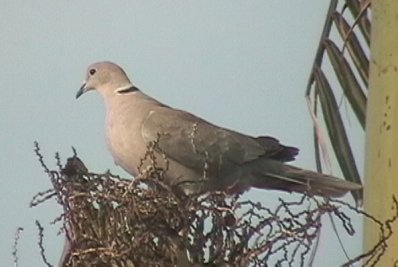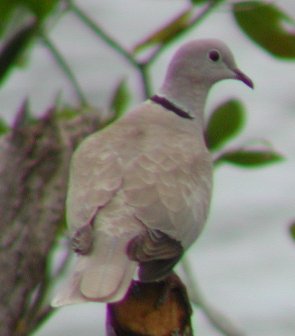|

Medium dove, pale gray overall with darker cinnamon-brown
wash over back. Nape is ringed with half-black collar that does not
extend to throat. Wings are mottled gray with dark primaries. Tail is
long, broad, edged with white (black near base).
Pink legs, feet.
|
EURASIAN-COLLARED
DOVE
Streptopelia decaocto
COLUMBIFORMES
Pigeons and Doves (Columbidae)
Range and Habitat
Native of India, Sri Lanka, and Myanmar; also widespread in Europe.
Introduced to the U.S.; occurs from Florida to Texas, and may be displacing
native doves.
SOUND: "hoo-hoooo-hoo", "krreeeew",
"hwaah", "krreair"
The Eurasian
Collared-Dove is one of two species that have been argued to be the
wild ancestor of the domestic Barbary Dove.
Their scientific name, Streptopeleia decaocto, literally means a collar
(streptos) dove (peleia). In Greek mythology, Decaocto was an overworked,
underpaid servant girl. The gods heard her prayers for help and changed
her into a dove so she
could escape her misery. The dove’s call still echoes the mournful
cries of her former life.
Introduced into the Bahamas in the 1970s, some migrated to Florida in
the 1980s. They went unnoticed at first because they look much like
the Ringed Turtle-Dove. It wasn't until the mid-1980s that ornithologists
realized the suddenly prolific and quickly spreading "turtle-doves"
they were watching were actually Eurasian Collared-Doves. Their impact
on native species is unknown; some have suggested that their spread
represents exploitation of a niche made available by the extinction
of the Passenger Pigeon.
A group of doves has many collective nouns, including a "bevy",
"cote", "dole", "dule", and "flight"
of doves.
The Eurasian-collared Dove is a terrestrial bird species that has a
current rating of Least Concern. This rating was downgraded from a previous
rating of Lower Risk in 2000. The range of the Eurasian-collared Dove
is about 10 million kilometers. The population of this bird species
is estimated at possibly 22 million individual birds. This bird species
is native to numerous countries throughout the world, particularly in
Asia, Europe and the Middle East. At the current time, the range and
population of the Eurasian-collared Dove is sufficient enough for no
immediate concern to be warranted.
 _____ _____
|